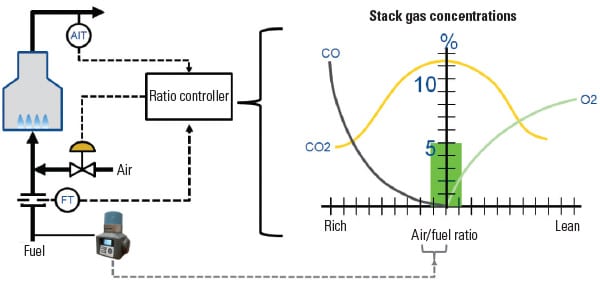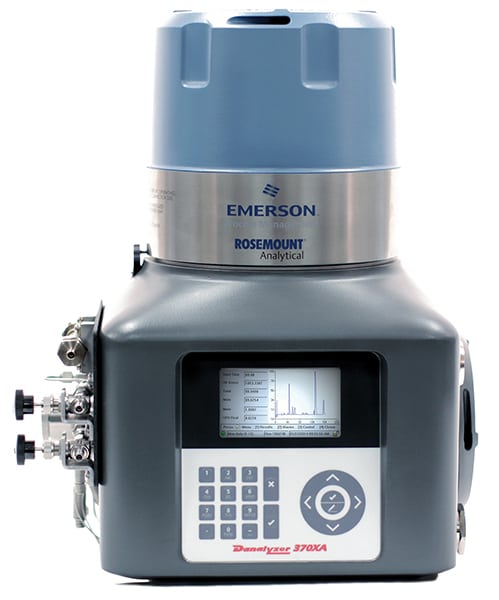Gas Chromatographs Offer New Technology for Power Plant Burner Control
Background burner control is critical for power and industrial plants because it affects emissions, energy costs, and process efficiencies. For natural gas burners, variations in gas composition can have a direct impact on the ability to maintain burner control and desired combustion characteristics, especially if the variations are rapid or transient. The magnitude of the impact can be severe, including unstable combustion, ignitability problems, increased emissions, and burner noise.
Historically, natural gas composition has been relatively stable. However, significant developments and diversification in the supply of natural gas (such as shale gas and liquefied natural gas imports) means that consistent gas quality can no longer be assumed.
The Benefits of Gas Chromatograph Technology
The industry employs a number of low-cost, reliable, analytical approaches to natural gas combustion processes to help monitor and control for changes in gas composition and gas quality. One solution that may not come immediately to a plant manager’s mind, however, is the use of a gas chromatograph (GC).
A GC can provide reliable natural gas heating value measurements, component composition, and physical properties to be used in feed-forward control strategies in a burner control system to help ensure optimal emissions, costs, and efficiencies. With the current state of natural gas, however, the use of a GC is not only a consideration, but in many cases, a requirement.
Unlike other analytical devices, the GC can provide individual component concentrations, not just calculated indices or inferred measurements. Additionally, because it is the same technology used and approved by the natural gas transmission industry for custody transfer applications, it provides a trusted measurement that can be used to check and validate energy billing from the plant’s supplier.
Some plant managers may believe GCs have high maintenance and operating costs, and require experienced analytical engineers to operate them. The fact is that GC technology has changed along with the increased demand for accurate natural gas composition measurement. GCs are now far more cost-effective and user-friendly than in the past, and new designs are suitable for real-world environments, like power plants.
Feed-Forward Control. The typical air/fuel ratio controller uses carbon dioxide and oxygen concentrations from flue gas analyzers to control the air/fuel ratio within an optimum combustion region. The emissions in the flue stack are monitored and fed back into the air/fuel ratio controller as a feedback loop. When the natural gas composition changes, emissions change. The controller then adjusts the air/fuel ratio appropriately.
However, a GC allows feed-forward control because it can provide the ratio controller with information on gas compositional changes before gas combustion, and therefore, before emissions are adversely affected. This provides a method to adjust the air/fuel ratio before increased emissions or hydrocarbons are detected in the flue stack (Figure 1).
Gas Composition. Using a GC to determine the gas composition provides insight into fuel quality variations from the gas supplier. The gas composition is critical, as even small variations in composition can cause significant process upsets if adjustments to the process are not made when the gas composition changes. Burner noise, flame stability, mixture ignitability, and emissions can all be affected when gas composition varies.
Not only can changing gas composition cause process upsets and impact performance, it can also cause burner instability issues, like flashback, combustion dynamics, vibrations, and noise that can significantly damage equipment, such as turbines. One major turbine manufacturer requires a permanent GC to be installed in the plant’s main gas supply line to monitor for variations in the composition of the gas.
Accurate determination of fuel gas composition allows for optimal adjustments of the air/fuel ratio, enabling the combustion turbine to operate at its most cost-effective efficiency point, while reducing NOx emissions. In the power industry, where emissions are closely regulated, operating cleaner and more efficiently can also save money by avoiding potentially costly fines.
C6+ Measurement. The industry’s standard method for determining the composition and physical properties of natural gas is through analysis known as C6+ measurement. This method determines the individual composition for each of the hydrocarbons from methane (C1) to normal pentane (C5), nitrogen, and carbon dioxide. The analysis combines heavier hydrocarbons (such as hexane, heptane, and octane) into a “C6+” component.
From the fuel composition, the energy content, specific gravity, Wobbe index, and other physical properties are determined, using calculations from international standards, such as ISO 6976, GPA 2172, and AGA 8. The C6+ measurement is the standard by which custody transfer billing is based and, therefore, provides a direct method of ensuring that the energy used matches the billing from the gas supplier.
C9+ Option. The likelihood that heavier natural gas coming from the supplier may include liquid hydrocarbons has increased. In some applications, liquid hydrocarbons entering the burner can cause significant damage to the equipment (such as in high-performance gas turbines) or adversely affect product quality. For these applications, the C9+ GC provides an extended analysis and the hydrocarbon dew point calculation to provide a method of protection against hydrocarbon liquids.
When heavier hydrocarbons or hydrocarbon liquids are present, movement of flame upstream in the combustion zone could occur, resulting in catastrophic damage to the turbine. A gas analysis measurement alone may not be entirely sufficient for the detection of heavy hydrocarbons, because it may only include the gases, but not the liquids in the stream.
It is also common practice to lump all hydrocarbons from hexane and heavier into one number. While this is perfectly acceptable for the calculation of the lower heating value, as long as the hexane and heavier hydrocarbons constitute a minute fraction of the gas, it will lead to a wrong estimate of the dew point. This is important, because measuring hydrocarbon dew point helps power plants with combustion turbines avoid turbine damage due to flashback. A C9+ GC can provide an accurate hydrocarbon dew point calculation, which indicates when risk increases, and attention is required.
Wobbe Index. Two unique fuel gas compositions may have the same energy content but behave much differently in the burner. This is because different amounts of diluents (nitrogen and carbon dioxide) and different ratios of the hydrocarbons result in different densities, and thus, different velocities through the burner restrictors. The Wobbe index is the ratio of the energy value to the specific gravity (Wobbe index = energy / √specific gravity). It provides an index related to how the fuel will act through a burner and provides a better variable to control the air/fuel ratio.
Real-World Applications
One large multinational industrial company uses GCs in its power generation plants to protect its turbines. The manufacturing company is concerned about the risk of heavier components in natural gas forming liquid hydrocarbons. The formation of the liquids can cause flashback, which can severely damage turbines.
The GCs provide an early warning of increased risk of liquid hydrocarbons forming by providing a hydrocarbon dew point calculation. The hydrocarbon dew point identifies the temperature at a given pressure at which the hydrocarbon components will condense out of a gaseous state into a liquid state.
Knowing the temperature at which liquid will form in this application enables the company to maintain the gas above that temperature and prevent the formation of liquids. If there are no liquids, there’s no risk of flashback, therefore using GCs helps reduce the threat of damage to the expensive turbines.
The same company uses a C6+ GC that provides a two-minute analysis. The GC in that application provides the heating value and specific gravity used to calculate the Wobbe index. That information provides an early warning of potential catastrophic turbine damage due to high flame dynamics and variations in the Wobbe index.
Reducing Cost, Increasing Simplicity
Often, people think a GC is a complex analyzer that’s difficult and expensive to operate and maintain. However, today’s GCs (Figure 2) are designed with ease of use in mind to ensure that operators and maintenance personnel, who may never have used one before, can quickly and easily start up, operate, and maintain the GC effectively.
Software assistants, contextual help, and built-in diagnostic functions make operating GCs easy and intuitive. The software assistants in the local operator interface can literally walk the technician through the process of changing calibration gases, optimizing valve timing, and replacing the analytical module in the GC. New models also include built-in diagnostic functions that provide fast support for common tasks and can automatically gather diagnostic data. They can even create and send email for a technical expert to review.
In addition to simplified maintenance, which makes it possible for many plants to use GCs without specially trained operators, new technology reduces costs, making GCs viable options in power plants. In some cases, installing GCs has cut calibration gas usage to less than half of the plant’s previous consumption, which offers direct savings on the calibration gas. It also means less time is spent replacing gas cylinders, or it allows smaller calibration gas cylinders to be used, reducing the installation footprint.
New modular designs include the columns, thermal conductivity detector, analytical valves, and solenoids in single units that can be quickly removed and replaced to reduce downtime. Downtime is reduced even when units are maintained and repaired in place, because the process of replacing a module in the field can often be done in a few hours, including warm-up time and purge. The design helps reduce overall operating costs.
Natural gas quality varies greatly, which means online measurement of gas composition is an important tool. Improvements in technology have made GCs a reliable solution to handle the task. For that and the other reasons previously mentioned, the addition of GCs should be considered at almost every gas-fueled power plant to improve efficiency and provide more precise control of burners. ■
—Bonnie Crossland is a Rosemount Gas Chromatographs product manager for Emerson.

